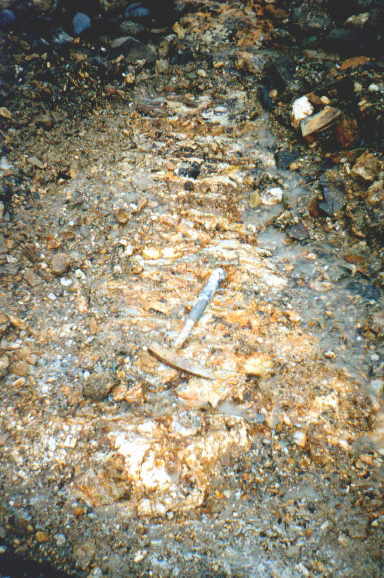Lode on:
[Wikipedia]
[Google]
[Amazon]
 In
In
 In
In geology
Geology (). is a branch of natural science concerned with the Earth and other astronomical objects, the rocks of which they are composed, and the processes by which they change over time. Modern geology significantly overlaps all other Earth ...
, a lode is a deposit of metalliferous ore that fills or is embedded in a fracture
Fracture is the appearance of a crack or complete separation of an object or material into two or more pieces under the action of stress (mechanics), stress. The fracture of a solid usually occurs due to the development of certain displacemen ...
(or crack) in a rock formation or a vein
Veins () are blood vessels in the circulatory system of humans and most other animals that carry blood towards the heart. Most veins carry deoxygenated blood from the tissues back to the heart; exceptions are those of the pulmonary and feta ...
of ore that is deposited or embedded between layers of rock. The current meaning (ore vein) dates from the 17th century, being an expansion of an earlier sense of a "channel, watercourse" in Late Middle English, which in turn is from the 11th-century meaning of ''lode'' as a "course, way".
The generally accepted hydrothermal model of lode deposition posits that metals dissolved in hydrothermal solutions (hot spring fluids) deposit the gold or other metallic minerals inside the fissures in the pre-existing rocks. Lode deposits are distinguished primarily from placer deposit
In geology, a placer deposit or placer is an accumulation of valuable minerals formed by gravity separation from a specific source rock during sedimentary processes. The name is from the Spanish language, Spanish word ''placer'', meaning "alluviu ...
s, where the ore has been eroded out from its original depositional environment and redeposited by sedimentation
Sedimentation is the deposition of sediments. It takes place when particles in suspension settle out of the fluid in which they are entrained and come to rest against a barrier. This is due to their motion through the fluid in response to th ...
. A third process for ore deposition is as an evaporite
An evaporite () is a water- soluble sedimentary mineral deposit that results from concentration and crystallization by evaporation from an aqueous solution. There are two types of evaporite deposits: marine, which can also be described as oce ...
.
A stringer lode is one in which the rock is so permeated by small veinlets that rather than mining the veins, the entire mass of ore and the enveined country rock is mined. It is so named because of the irregular branching of the veins into many anastomosis stringers, so that the ore is not separable from the country rock.
One of the largest silver lodes was the Comstock Lode in Nevada, although it is overshadowed by the more recently discovered Cannington Lode in Queensland, Australia. The largest gold lode in the United States was the Homestake Lode. The Broken Hill Lode in South Australia is the largest lead-zinc lode ever discovered.
See also
*Lodestone
Lodestones are naturally magnetization, magnetized pieces of the mineral magnetite. They are naturally occurring magnets, which can attract iron. The property of magnetism was first discovered in Ancient history, antiquity through lodeston ...
known just as ''lode'' in the 16th and 17th centuries.The '' New Oxford American Dictionary'' (''NOAD''), 3rd edition.
* Mother lode, the principal vein
* Ore genesis
* Thickness
* General Mining Act of 1872
* Land patent
* Binger Hermann
*Surveying
Surveying or land surveying is the technique, profession, art, and science of determining the land, terrestrial Plane (mathematics), two-dimensional or Three-dimensional space#In Euclidean geometry, three-dimensional positions of Point (geom ...
*Geographic information system
A geographic information system (GIS) consists of integrated computer hardware and Geographic information system software, software that store, manage, Spatial analysis, analyze, edit, output, and Cartographic design, visualize Geographic data ...
Notes
{{Authority control Ore deposits Mineralogy Economic geology